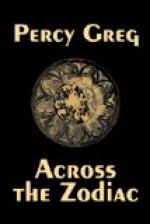less than a power of 100 reveals to an eye situated
in space; though, from the nature of the lens through
which I looked, I cannot speak with certainty upon
this point. With a magnifying power of 300 the
polar spots of Mars were distinctly visible and perfectly
defined. They were, I thought, less white than
they appeared from the Earth, but their colour was
notably different from that of the planet’s
general surface, differing almost as widely from the
orange hue of what I supposed to be land as from the
greyish blue of the water. The orange was, I
thought, deeper than it appears through a telescope
of similar power on Earth. The seas were distinctly
grey rather than blue, especially when, by covering
the greater part of the field, I contrived for a moment
to observe a sea alone, thus eliminating the effect
of contrast. The bands of Jupiter in their turn
were more notably distinct; their variety of colour
as well as the contrast of light and shade much more
definite, and their irregularities more unmistakable.
A satellite was approaching the disc, and this afforded
me an opportunity of realising with especial clearness
the difference between observation through seventy
or a hundred miles of terrestrial atmosphere outside
the object glass and observation in space. The
two discs were perfectly rounded and separately discernible
until they touched. Moreover, I was able to distinguish
upon one of the darker bands the disc of the satellite
itself, while upon a lighter band its round black
shadow was at the same time perfectly defined.
This wonderfully clear presentation of one of the
most interesting of astronomical phenomena so absorbed
my attention that I watched the satellite and shadow
during their whole course, though the former, passing
after a time on to a light band, became comparatively
indistinct. The moment, however, that the outer
edge passed off the disc of Jupiter, its outline became
perfectly visible against the black background of
sky. What was still more novel was the occultation
for some little time of a star, apparently of the tenth
magnitude, not by the planet but by the satellite,
almost immediately after it passed off the disc of
the former. Whether the star actually disappeared
at once, as if instantaneously extinguished, or whether,
as I thought at the moment, it remained for some tenth
of a second partially visible, as if refracted by
an atmosphere belonging to the satellite, I will not
venture to say. The bands and rings of Saturn,
the division between the two latter, and the seven
satellites, were also perfectly visible, with a distinctness
that a much greater magnifying power would hardly
have attained under terrestrial conditions. I
was perplexed by two peculiarities, not, so far as
I know, hitherto [5] mentioned by astronomers.
The circumference did not appear to present an even
curvature.




